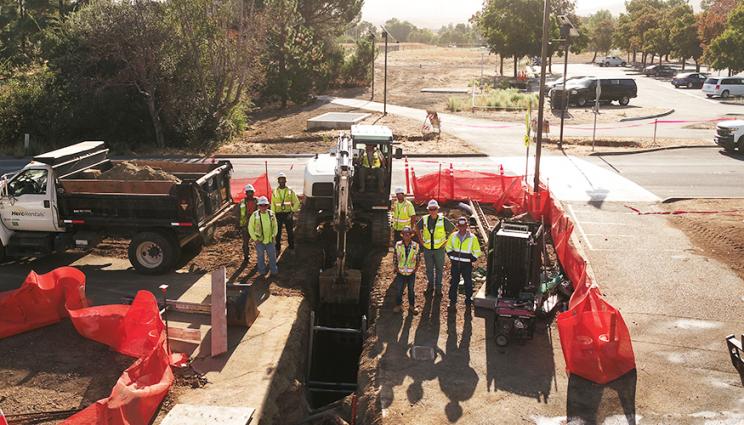
Construction crews completed the Expand Electrical Distribution System (EEDS) project several months early and more than $1 million under budget. The upgrade will provide Lawrence Livermore National Laboratory and Sandia/California with reliable, redundant underground power, as well as supply electricity to new development on the east side of the Laboratory.
Construction crews recently wrapped up a long-anticipated electrical system upgrade that will supply Lawrence Livermore National Laboratory (LLNL) and neighboring Sandia/California with reliable, redundant underground power, completing it months ahead of schedule and well under budget.
The first line-item project for LLNL in more than a decade, the Expand Electrical Distribution System (EEDS) project involved seven years of planning and broke ground in December 2017. As part of the project, workers dug an 11,000-foot trench along the east side of the Laboratory and installed high-voltage feeders in an underground duct bank with approximately 75,000 feet of conductors and two load-grid switchgear stations.
Performing on behalf of the U.S. Department of Energy's National Nuclear Security Administration (DOE/NNSA), crews completed the project in late August, well ahead of its scheduled date of December 2020. Its final cost of $32.7 million was $1.1 million under budget. This included the completion of $1.8 million in additional work bid out to multiple subcontractors and awarded in the last few months of the project. This work was identified in the planning stages as additive alternates.
The upgraded infrastructure, which includes new electrical feeds to the Lab from the Western Area Power Administration's Livermore Substation, eliminated single points of failure at Sandia and the National Ignition Facility. It will supply power to new buildings on the Laboratory's east side and the future expansion of the Livermore Valley Open Campus, as well as add capability to the Livermore Computing Center facility and increase the serviceability and safety of the Lab's high-voltage system, according to LLNL Senior Project Manager Jim Haslam.
"This was a huge team effort and it really brought out the best in the Lab," Haslam said. "We polished off and improved policies that hadn't been looked at in decades - a lot of people had never been through some of the challenges we went through. We formed some fantastic relationships to get through the tough times, and we had a lot of tough times. It was a huge challenge and it really brought people together to ensure its success. I'm just super happy and proud of my team."
The project team included dozens of personnel from LLNL, DOE and subcontractor Nova Probst, and required more than 59,000 labor hours, with no lost time or recordable accidents, Haslam said.
"After many years of not performing line-item-sized project work at LLNL, this team proved that we are capable of executing not only this project, but all of our line-item projects that will be arriving in a few short years, including the next wave of NNSA Defense Programs projects," said LLNL Deputy Principal Director for Projects Mark Watts. "Working under high-hazard conditions, this team delivered as planned, overcoming numerous challenges in excavating through contaminated materials, a complex network of underground utilities and unexpected buried debris. I want to thank this team for establishing the confidence that our stakeholders now have to authorize larger and more complex projects at the Laboratory."
With an expected service life of more than 40 years, the upgrade addresses critical NNSA electrical infrastructure needs by providing sufficient capacity to support current and future national security missions and the flexibility to adapt to new technology and more stringent safety, security and environmental regulations, according to NNSA.
"The project is critical for meeting NNSA's mission deliverables both now and into the future," said Bob Raines, NNSA associate administrator for the Office of Acquisition and Project Management. "It also will eliminate possibilities of single-point failures to current facilities and to support planned future development."






